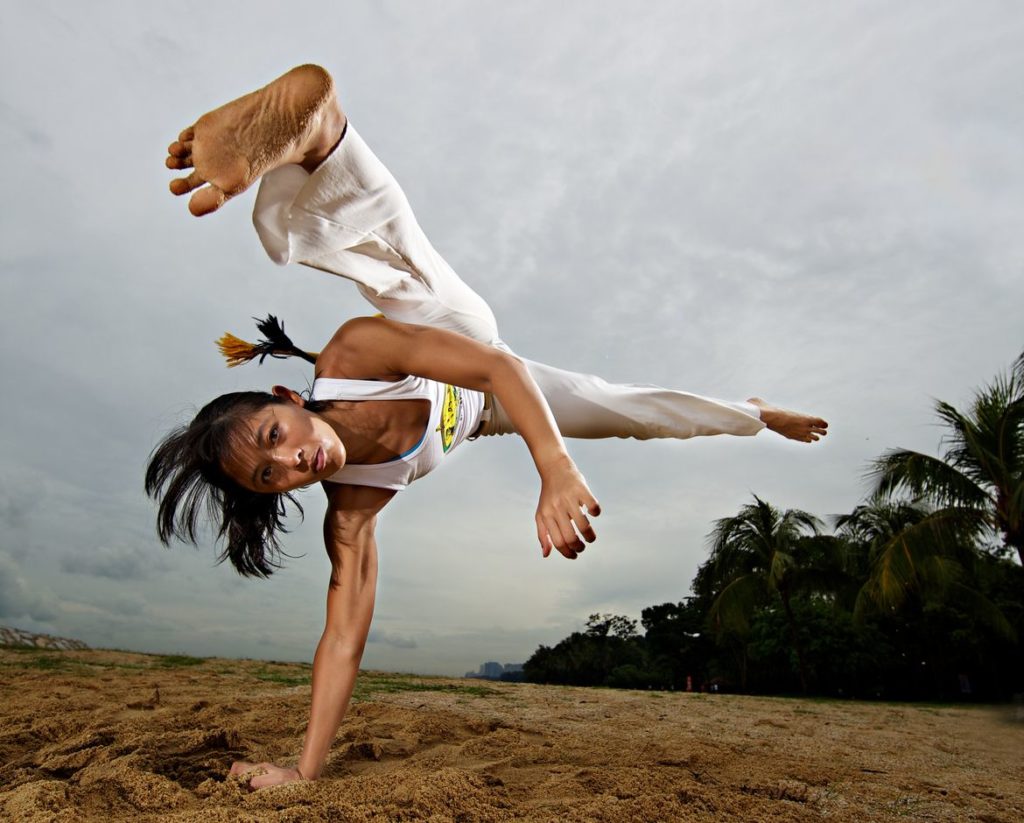Capoeira is an Afro-Brazilian martial art that combines elements of dance, acrobatics, and music with fighting techniques. It was developed by enslaved Africans in Brazil at the beginning of the 16th century. Capoeira is known for its acrobatic and complex maneuvers, often involving hands on the ground and inverted kicks.

Capoeira is also one of the fighting styles used by Mixed Martial Artists (MMAs) in combat, however, some students pursue Capoeira purely as an aerobics exercise for its cardio, strength and conditioning benefits. As such, Capoeira practitioners tend to fall into two categories: those who enjoy the sport for its combat aspects and those who appreciate it for the playful dance-like nature of the art form.
To practice Capoeira is to experience freedom, the joy of self-expression and the Zen-like state of living in the moment. Some students think of it as exercise or a fighting discipline, while others perceive Capoeira as a form of play. A typical capoeira event includes traditional Brazilian music, precise kicks, evasive defense moves, and often stunning acrobatics.
In the words of one master, Capoeira is “a dance that is a fight and a fight that is a dance.”

As a Capoeira instructor you’ll be able to design classes that emphasize one or the other, perhaps both. In this way your course offerings can appeal to the widest possible range of students. You’ll also enjoy the professional satisfaction of guiding your students to great physical condition, while helping them achieve inner peace and grace of movement. The potential income as a Capoeira instructor is also above average.
Ready to dive in? Read on to discover what you’ll need to do to prepare for a career as a Capoeira instructor.
In this article you’ll learn:
- How much money you can make as a Capoeira instructor
- The required training and certifications
- Professional groups to join
- Employment opportunities for Capoeira instructors
- Finding clients
- Plus helpful tips
How much money can you make?
Capoeira instructors average $80,781 per year according to a recent study by SimplyHired. Instructors on the high end of the pay range report salaries of more than $100,000 per year. Many operate their own Capoeira studios, training students themselves or with the assistance of employed instructors.
Training and Certification
There is no formal licensure requirement to teach Capoeira. But to gain employment, you’ll need training and certification to prove you are qualified to teach. Because Capoeira is such a highly specialized and distinctive martial art, a degree in fitness or experience with other martial arts, while helpful, won’t be enough to land a job. You’ll also need a business license if you plan to operate your own school, as well as carry liability insurance and be certified in basic first aid, including CPR.

Training programs leading to certification for Capoeira instructors are widely available, both as online courses and in-person instruction. Look for programs endorsed by the World Capoeira Federation.
Capoeira disciples fall into five categories:
- Aluno – Student (6-12 months experience)
- Graduado/Monitor – Advanced Student (5-7 years of experience)
- Instructor/Professor – (8-12 years of experience)
- Contra Mestre – Right-Hand of the Mestre (15 years of experience)
- Mestre – Master (25 or more years of experience)
While you can study online to be an instructor, learning from videos and videoconferencing with a master, pursuing in-person training will give you much more individualized attention with immediate feedback. Ultimately, your decision will come down to your budget and ability to travel, as the major Capoeira training centers in the United States tend to be concentrated in New York and Southern California.
Professional Groups to Join
Show the world you are serious about Capoeira and your career by signing up for a membership in one or more professional organizations. These credentials make your resume stand out from competitors when you’re looking for a job. They are clear evidence of dedication to the sport and your professionalism. That’s not all. You can network with other members and make new friends. These are people in the right position to help you find jobs.
Professional memberships are also a terrific resource for ongoing training, learning new coaching ideas and training plans, plus the unique enjoyment of being part of a group who shares your passion. Here are some professional groups to consider:

The World Capoeira Federation is an international non-profit organization whose primary mission is to promote Capoeira as a sport for inclusion in the Olympic Games.
The Martial Arts Teachers Association offers training and certification for instructors, plus deep resources for learning how to run a profitable martial arts studio, as well as access to affordable insurance plans. Membership is $37 a month or $199 for a full year paid in advance.
The World Wide Martial Arts Association is a non-profit organization that provides instruction to members, hosts training camps, supports coaches and students, and publishes educational materials. The USMAA is a large governing body that works to spread the values and high-quality examination, testing, and instruction standards. Certification is available through the USMAA.
Employment
Look for job opportunities for Capoeira instructors at martial arts studios, public recreation centers, the YMCA, and larger gyms with extensive fitness programs.

You’ll want to make copies of your resume, both printed and for online distribution. When sending resumes by email, the best way to attach this document and supporting materials is by creating .pdf files of the documents with Adobe Acrobat. These types of files are considered safe to send and are less likely to trigger a spam alert in the recipient’s mailbox. Follow this tip and you’ll have a much better chance that your online correspondence lands in front of a real person, not a spam folder.
Also make photocopies of your professional certifications and memberships in Capoeira organizations and clubs. These extra materials can pull your application to the top of the pile and set you apart from competitors vying for the same job.
Finding Clients
An attractively designed website and business cards should be the core of your marketing toolkit as a Capoeira instructor. The website can be as fancy as you like, so long as it looks professional, with photos of your Capoeira studio, students practicing their moves and a few images of you in action, teaching students. Your business location and contact information should be clearly visible at the top of every page on your website. Search engines scan this information to match your website geographically with people searching for a Capoeira instructor.
In addition to your business website, the next thing to do is create an Instagram account to showcase your Capoeira studio. Instagram is the #1 online venue for professionals to promote their work. It’s a free marketing tool that’s always working on your behalf.
Now set up a Facebook page for your Capoeira school. This is a great way to build a following and keep people up-to-date on your offerings.

Be sure to create a Google My Business page, where you can add hours of operation, photos and an interactive map of your location.
All of the above services are free. It shouldn’t take more than an hour to set up a page on each site, including photo uploads.
Other strategies for attracting new business:
- Create a referral program with discounts for your Capoeira students who bring new people to class.
- Ask students to review your Capoeira training program online. According to a recent survey, 90% of people say their purchasing decisions are influenced by positive online reviews.
Good to know
There are five core moves in Capoeira that should be the foundation for beginners learning this martial art. You could easily build at least five lesson plans around these moves:
Ginga
This is a combination of partial range Squat and Lunge, resembling a rocking back-and-forth dance move. The goal is to improve coordination. Once students are adept at performing Ginga, other Capoeira footwork usually becomes easier.
Spinning Kicks
These roundhouse kicking techniques help students learn to move within the Capoeira circle.
Escapes
These moves are similar to dodges in boxing. Escapes come from the Portuguese word “Esquivas.” All of these moves involve getting the head and torso out of the way of an attack.

Floor Transitioning
These moves enable Capoeira students to switch between various acrobatic maneuvers so they can move in any direction from any position.
Frontal Kicks
A form of attack, the frontal kick is used in takedowns and counter takedowns. Students who achieve mastery with frontal kicks are ready to advance to more challenging maneuvers.
If you enjoyed this article, check out some more great PocketSuite.io content that can help you grow your career as a Capoeira instructor. Here’s a great place to start.PocketSuite has thousands of business owners who all started where you are right now. Our community is always happy to help you ramp up, grow your client base, and achieve your income goals, both within the PocketSuite app and as part of our exclusive Facebook Community Group. PocketSuite’s vision is for any professional to be able to work for themselves and make a great living. It starts here. It starts with you. It starts today. Let’s get started, download PocketSuite now! Feel free to reach out with any questions (we’d love to hear from you)! Text us @ (415) 841-2300.





